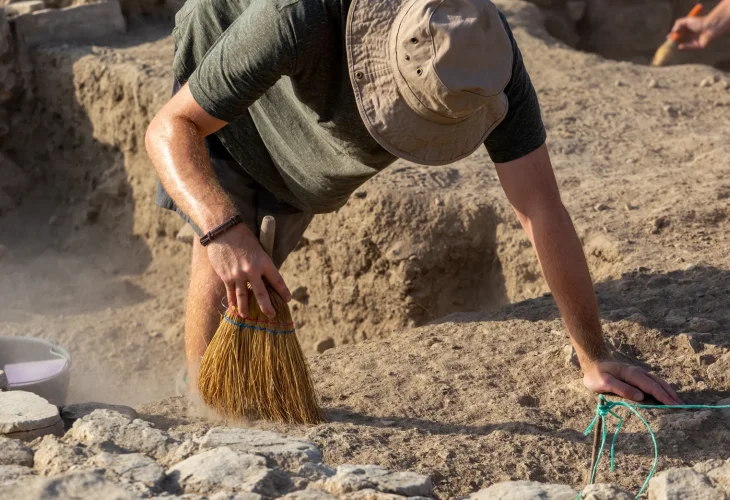Ancient Seals: What Archaeological Evidence Reveals About Early Jerusalem
We have discovered seals and inscriptions referencing several individuals mentioned in the Book of Jeremiah. Why do we find so many parallels specifically from Jeremiah, but fewer from other books?
 (Photo: shutterstock)
(Photo: shutterstock)A few days ago, a seal was uncovered during excavations in the City of David. In ancient times, people of status often kept small seals, typically made of stone. These seals were imprinted onto their pottery. The impression would be made when the clay was soft, permanently capturing the design. Seals could also be pressed into a 'bulla' used to seal letters or documents that needed to be closed and authenticated. The bulla, made of soft material, would receive the seal's impression, thereby verifying the sender's identity.
The seal that was found bears the name of its owner: "Yeho'ezer son of Hosha'yahu." Researchers speculate that the seal belonged to Azaryahu son of Hosha'yahu, mentioned in Jeremiah chapter 43 as a senior official in the land of Judah. Officials of such rank often had personal seals.
Interestingly, we have discovered numerous seals and inscriptions referencing individuals mentioned in the Book of Jeremiah.
The most significant is Baruch son of Neriah, the scribe of the prophet and his disciple (Jeremiah 36:4). Several decades ago, a seal bearing the inscription "to Berechiyahu son of Neriyahu the scribe" was found, dated precisely to the time of the destruction. It is clear this is the seal of the prophet's scribe, Baruch son of Neriah. Baruch aspired to prophecy himself and prepared extensively for it, but never achieved it, remaining Jeremiah's scribe.
In 1982, archaeologist Yigal Shiloh discovered in the City of David a seal impression with the name "Gemaryahu son of Shaphan." This personality is also mentioned in Jeremiah (36:10) as a scribe, likely a descendant of the famous scribe Shaphan mentioned in the days of Josiah.
Another find from a few decades ago is the seal of "Yerahme'el son of the king," discovered in the Old City area of Jerusalem. Yerahme'el son of the king is also mentioned in Jeremiah (36:26). The title "son of the king" was given not only to biological sons but to those the king raised as sons.
Archaeologist Eilat Mazar, who conducted excavations in the City of David, discovered two seals related to people mentioned in the Book of Jeremiah, several years apart. In 2005, she found the seal of "Yehuchal son of Shelemiah," mentioned in Jeremiah (37:3) as a notable officer, and in 2008, she found a bulla (a clay imprint, much more fragile than the seal itself) bearing the name of "Gedaliah son of Pashur," mentioned in Jeremiah 38:1. The bulla was discovered within the "Large Stone Structure," which Mazar theorized might be a royal palace.
Two more seals were found in Jerusalem about fifty years ago: the seal of "Jaazaniah servant of the king," which, according to archaeologist Yavin, refers to Jaazaniah son of the Maachathite, an officer of the king (Jeremiah 40:8); and the seal of "Seraiah son of Neriah," mentioned in Jeremiah (51:59) and found in Jerusalem.
A very famous person is mentioned in the Book of Jeremiah, whose assassination we commemorate annually right after Rosh Hashanah: Gedaliah son of Ahikam. He was the leader who united the remnants of the people in the Land of Israel. His murder led the remaining population to flee to Egypt, leaving the land desolate. Gedaliah son of Ahikam resided in the city of Mizpah (Jeremiah 40:6). Some believe its location is "Nabi Samwil," a very high ridge offering distant views.
But that is not all. The findings teach us much more about the names mentioned in the Book of Jeremiah. In 2006, a bulla of an officer named "Ga'alyahu son of Immer" was discovered. This name does not appear in the prophet, but in Jeremiah 20:1, "Pashur son of Immer, the officer in charge of the House of Hashem," is mentioned. It's likely Ga'alyahu was from the same family. Ga'alyahu is mentioned in an inscription found in Arad, one of Judah's fortified cities, where he is described as a courier carrying letters. He may have been a messenger from Jerusalem, bearing urgent letters about the Babylonian conquest.
Similarly, we know of the Lachish Letters, from the fortified city of Lachish in Judah. These potsherds document the invasion and were sent from the capital, Jerusalem. The letters were written on potsherds instead of paper, thus preserved. The names in the Lachish Letters are very similar to those in the Book of Jeremiah. It's likely these names were common at the time, and perhaps another recognizable figure might emerge. One Lachish Letter mentions a prophet whose name ends in "-yahu," stating his words "do not encourage— weakens the hands." It might have been Uriah son of Shemaiah, the prophet who prophesied about the destruction (Jeremiah 26:20).
Why do we find so many parallels specifically from the Book of Jeremiah, but fewer from other books? The answer is quite simple: Jeremiah's time was a 'layer of destruction.' Famously, during his days, Jerusalem and the entire land were destroyed. Cities were burned, and the mounds buried the artifacts, waiting patiently for thousands of years, unlike earlier times when life continued on its course. The destruction provides a sort of 'snapshot' preserved until the excavation and clearing of the mound.

